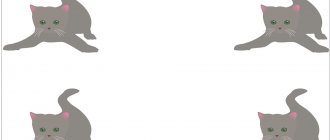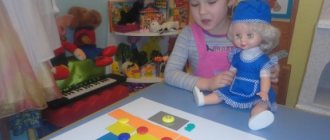Elena Sibikina
Lesson summary "Game situations according to traffic rules"
Game situations according to traffic rules.
Goal: Consolidating children’s understanding of traffic rules in a playful way .
Tasks:
— expand children’s understanding of the rules of behavior on the street;
- promote the development of attention and prudence;
— develop the ability to behave correctly on the road.
In our preschool every year, events are organized and carried out aimed at preventing road traffic injuries:
Teaching junior and senior preschoolers in kindergartens traffic rules (traffic rules)
and the prevention of child injuries on the roads is an obligatory part of the educational process in preschool educational institutions.
Statistics show that children themselves are often the cause of road accidents. A child is not a small adult; his body is in a state of growth and development, and not all mental functions that are so necessary for adaptation in the world are fully formed. Children are dynamic, excitable and at the same time absent-minded; they are not able to foresee danger, assess the real distance to a moving car, its speed, as well as their capabilities.
In the process of classes , it is necessary to develop certain knowledge, skills, and abilities in children.
Children should:
— know how a traffic light works, at what signal you can cross the roadway;
— master the concepts: driver, passenger, pedestrian; use them in speech;
— know how to behave at a pedestrian crossing;
- have an idea of what a roadway or sidewalk is.
The upbringing of preschoolers is carried out on the basis of general didactic principles: accessibility, scientificity, systematicity, awareness, visibility, connection of theory with practice, strength of assimilation of knowledge, skills, abilities.
Today the kids and I played out a situation at a pedestrian crossing. Where children could clearly feel like a real traffic police inspector, a driver and just pedestrians. Everyone liked it; in the process, we explained what a traffic light is and what it serves, how a traffic police inspector works, and, of course, the rules of behavior on the road.
Physical school
.
Educator: Have you seen signs or tables along the roads? These are road signs. What does each road sign mean? Children look at portable road signs and call them: “Pedestrian crossing”
,
“First aid station”
,
“Gas station”
,
“Food station”
,
“Telephone”
,
“Parking area”
, etc.
Every day thousands of people walk around the city, and no less number of vehicles travel. To ensure order reigns in the city and there are fewer car accidents, pedestrians must adhere to the rules and traffic signs. It is important to teach growing children the rules of the road so that you can be calm about them when they go outside without a parent. You can teach your child the rules of behavior on the road in a playful way or in poetry so that he doesn’t get bored.
If every person follows traffic rules, there will be harmony in the city and the number of traffic-related accidents will decrease. In addition to the rules, there are also road signs for children, the essence of which is also important to explain to them.
Traffic light
We stopped, and all the other cars stopped, and the bus stopped. I asked, “Why?”
Mom explained: “You see the red lantern? This is a traffic light"
.
I saw a flashlight on the wire above the street. It glowed red.
“How long will we stand?”
"No. Now they’ll pass by, who needs to cross the street, and we’ll go.”
And everyone looked at the red flashlight.
Suddenly it lit up yellow, and then green.
And off we went.
Then once again a red flashlight was burning on the street.
“Uncle, stop! Red fire!
The driver stopped the car, looked back and said: “You’re great!”
We stopped again, but there was no light at all. Only I saw a tall policeman in a white cap and a white jacket. He raised his hand up. When he waved his hand, we drove off. As the policeman raises his hand, everyone will stand up: cars, buses.
E. Zhitkov
It often happens that many parents, even those who have a driver’s license, cannot correctly convey to their child basic knowledge about behavior on and near the roadway, at stops and in transport. Limiting yourself to the phrases “Stop, there is a road”
,
“Walk with me by the hand”
and
“You can’t”
, they are raising an illiterate pedestrian.
And then all hope is for kindergarten and school, they say, they will teach you there. The process of understanding and mastering traffic rules is a very complex and long process, which should consist not only of mom and dad explaining “How you can”
and
“How you can’t
. Traffic rules for children should become an important part of education in every family. Children can and should be taught such important rules from the age of one and a half years. Usually they begin to pay a lot of attention to this when the baby can move independently. Of course, at this age, the child will not yet be able to remember where to look when crossing the street and what light to stop at. This does not mean that there is no need to study.
"Travel by Car"
Goal: to consolidate with children the knowledge of road signs and rules of behavior on the streets.
Material: playing field , chips.
Pictures of road signs
Clear drawings of signs with analogies will help you remember the most important symbols that you will encounter on your way to elementary school or kindergarten. Vivid images and simple explanations allow you to instantly attract attention and convey information quickly, cheerfully and clearly.
Thanks to road pictures, the child learns to be independent and make the right decisions. The main goal is to show that participation in traffic is not as scary as it may seem. If you understand the meaning of road signs, you can organize your own actions.
Road pictures are different for each age category. Children learn in the presence of an adult, who prompts actions and explains signs.
Pictures of traffic rules for children
This is a fun activity for different age groups, which at the same time brings great benefits. Every child, just starting to walk, becomes a participant in traffic - goes to kindergarten or school, walks in the yard, learns to ride a bicycle. Studying from strict books is boring and difficult, so as an alternative we offer bright drawings with clear messages.
The learning process attracts the child with its accessibility and diversity. Any adult can help understand the images by adding examples from personal experience to the drawing. As a result, confidence in himself and his actions in any situation is formed, he will not be confused or scared at the sight of a moving car and will know what to do at a pedestrian crossing. Traffic rules drawings are quick answers to children's questions.
Didactic games on traffic rules in the senior group
Preschoolers in the older group already know the rules of behavior on the street; they just need to generalize the knowledge. During games, children develop memory, speech skills, observation, and their spatial orientation improves. It is important to develop discipline in older preschoolers and the desire to follow traffic rules in everyday life.
Rod of Knowledge
The game generalizes preschoolers' knowledge about the correct behavior of pedestrians. The teacher divides the students into 2 teams. To practice, you need to take a toy traffic controller’s baton, or make one yourself.
The leader alternately gives the baton to the players of different teams. The player who received the item must remember the rule of safe behavior for pedestrians. You can't repeat yourself. The team that gives the most correct answers wins.
Example answers:
- the pedestrian must walk on the sidewalk;
- when crossing the street you need to look to the left, then to the right;
- in the absence of a sidewalk, it is permissible to walk along the side of the road towards moving cars;
- Crossing the street is permitted when the traffic light is green;
- You cannot play on the road or in its immediate vicinity;
- You must not cross the road when vehicles are approaching.
Safe streets
The purpose of the didactic game on traffic rules is to form an idea of correct walking and wheeled movement along city streets, consolidating knowledge about regulatory signs.
The board game is intended for 2-3 players. For it you need to prepare a playing field with a schematic representation of city streets, figures of people, road signs, cars, traffic lights. You can buy a ready-made board game, or you can find it on the Internet and print it out.
The teacher distributes signs and symbols across the field. Players disassemble figures of people and cars. Characters and vehicles can be completely different. You can come up with any scenarios. For example, a schoolchild returns home after school, or a truck carries groceries to the store.
Players take turns rolling dice to move characters along the street. If this is a pedestrian, then he is moved by as many cells as there are dots on the die. If a cyclist, the number of “steps” is multiplied by 2. If a motorist, multiplied by 3. A player moving in a vehicle can accept passengers and leave the car in the parking lot. In the latter case, he becomes a pedestrian. When a cube hits an underground passage, the player can immediately, in one move, move to the opposite side of the street. And if you get into an area marked as dangerous, you have to skip a move.
Guess the sign
The game improves visual and auditory perception, teaches preschoolers to remember the visual form of a road sign when mentioned verbally. To play, you need to prepare a lotto with images of different signs, as well as blank sheets of paper the size of the pictures.
The game involves 3-6 children. The teacher lays out the lotto in front of each person and distributes paper. Then he reads out a riddle or part of a poem regarding a specific road sign. The players’ task is to understand what sign is being talked about, find it on the lotto, and cover it with a sheet of paper. The winner is the one who covers all the pictures correctly and faster than his opponents.
Driver
The game consolidates knowledge of traffic rules, improves thinking ability and the ability to navigate in space. It is necessary to prepare several options for playing fields depicting streets with infrastructure and regulatory signs. It is important that the fields allow you to play out different situations on the road. A small toy car is also needed.
The teacher gives the student a task consisting of a series of actions. For example, “go to the clinic, then fill up with gas at the bus station, buy groceries at the store on the way home.” The task in the game is to do everything that is said without breaking the traffic rules. The path begins with an image of a garage or parking lot and should end there.
My street
Do-it-yourself didactic games on traffic rules are very interesting; a teacher can make a model of a street with children. For older kindergarteners, this is an extremely exciting activity. It’s good if the model represents a real street on which the kindergarten is located. All traffic lights, zebra crossings, traffic signs, and vegetation are required. We also need figures of vehicles and pedestrians.
At the first stage of the game, children examine the model made, answer the teacher’s questions, pointing with their finger what they mean or putting the characters in a certain place. What are these questions:
- what buildings are located on the street;
- traffic here is one-way or two-way, how many lanes are there on the road;
- is there an intersection on the street, how to cross it correctly;
- where are the pedestrian crossings, how are they marked;
- where pedestrians walk, where cars drive, is it possible to go out onto the roadway;
- how traffic is regulated, where traffic lights are located;
- is there public transport on the street, what is it for, where are the stops;
- what do the road signs on the street mean?
At the second stage of the game, the teacher asks the students to take turns “driving” and “walking” along the street, observing the rules of safe movement. Children who make no mistakes in completing the task receive a prize.
Road alphabet in pictures
This is play-style learning. Vivid images are better remembered and attract children's attention better than dry texts and abstruse phrases. This alphabet has a dual function - visual teaching of literacy plus familiarization with road traffic and its participants. The child will easily remember the order of letters in the alphabet and their spelling, and will also know the designations of markings, signs, vehicles, etc.
The participation of an adult in the process of learning the alphabet can only be limited to testing the acquired knowledge. Colorful pictures and simple explanations are learned by children of different ages. As a result, the child is well oriented in traffic situations, learns in which places to cross the road, and will be able to distinguish between traffic lights and road sign designations.
Didactic games on traffic rules in the younger group
Kids should understand the names and purposes of vehicles, traffic lights, and main road signs.
Find the extra word
The teacher names 4 words, and the children must say which one is superfluous in meaning. Examples:
- tram, barn, tractor, ambulance;
- swing, excavator, trolleybus, truck;
- boat, boat, bus, yacht;
- scooter, roller skates, bicycle, car.
Traffic light repair
To play, you need a contour image of a traffic light and 3 circles corresponding in size to its “eyes”: red, yellow, green. The teacher explains to the students that the broken device needs to be repaired. Children place circles on the traffic lights in the correct sequence and tell what each color signals.
Collect the sign
To play the game, you need to print and cut into several parts images of road signs familiar to preschoolers of the younger group. It is also necessary to make copies of the pictures that players will use as a guide when folding the cut images. If a child quickly puts together pictures, you can ask him to complete the task without a sample.
Stop or go
For the game, the teacher prepares 2 signal cards - red and green. Hands out steering wheels made of cardboard to children. The teacher explains that when he shows the green card, the players should move as if driving a car. When the green card turns red, you need to brake.
We run across the road
The presenter has 3 cards corresponding to traffic lights. When the green one is raised, children run around the playroom, when the yellow one is shown, they jump or dance in place, and when the red one is shown, they stand still. Those who make mistakes are eliminated. The last player remaining wins.
Garage
Hula hoops are placed in the corner of the playground - these will be cars parked in the garage. There should be 4-8 fewer of them than players. The teacher turns on the music, the children dance. When the music stops, the players rush to the “garage” and hula hoop one at a time. Those who do not have time are eliminated.
Non-existent road signs
This is a great conceptual way to develop a child's understanding of the world. Based on simple drawings, the child develops logical thinking, associative perception, and adapts to social life. Road traffic is an integral part of modernity, vehicles and pedestrians intersect everywhere. Understanding the basics of traffic rules means being safe.
Pictures with non-existent road signs are beneficial because they develop in the child an idea of real symbols that need to be followed. At the same time, fantasy develops thanks to imaginary objects. Children easily reproduce or invent new colorful images. This learning process is built in a game format and is preparatory to further study of the signs from the Rules.
Didactic games on traffic rules in the preparatory group
Preschoolers in the preparatory group are preparing for school; they already know about the rules of behavior on the street and in transport, and understand road signs and markings. You just need to consolidate this knowledge. It is also important to pay attention to the speech and mental development of preschoolers.
Find the sign
Children are shown lotto pictures depicting different situations, but without road signs. The players’ task is to find a suitable one among the separately prepared signs and put it in the picture where it should be in reality.
I am a passenger
The teacher shows the students cards depicting different situations in public transport. Players take turns taking pictures, telling what they see: whether the characters are doing the right thing or not, if not, then they explain what they would do.
Name the signs
A couple is playing. Players take turns naming the road signs they know. The one who remembers the most wins.
Crossroads
The teacher introduces students to the types of intersections, shows the corresponding pictures, and tells them how to cross them correctly. Children should learn that intersections can be controlled or unregulated, and their configurations are cross-shaped, T-shaped, Y-shaped, or with a roundabout.



